Brian Clegg's Blog, page 105
January 3, 2014
A quite interesting year
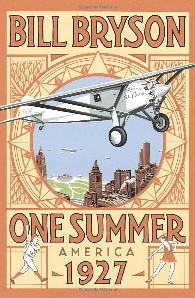 The 'quite interesting' year I refer to is not a look back at 2013, but a glimpse of the summer of 1927 given to us by Bill Bryson in his latest book. In fact a glimpse is a bit of an understatement as a description of this doorstep of a tome.
The 'quite interesting' year I refer to is not a look back at 2013, but a glimpse of the summer of 1927 given to us by Bill Bryson in his latest book. In fact a glimpse is a bit of an understatement as a description of this doorstep of a tome.As the cover suggest, one of the major themes of the book is the rise to outstanding fame of Charles Lindbergh as a result of his aerial Atlantic crossing. As Bryson surprisingly informs us, this was not actually the first crossing by air but around the 120th. It had certainly been done by plane earlier by Alcock and Brown. But somehow Lindy's flight caught the imagination of the world and he became a superstar.
The rise and fall of Lindbergh occupy a fair amount of the book, but we also meet his competitors and other notables of the period in America from politics to sport (notably baseball and boxing) and bringing in everything from famous murders of the period (through to the details of their electrocution) to the sad disaster that was prohibition and the gangsters who profited from it.
Overall, Bryson's skill is in weaving all this together into an enjoyable tapestry. If I'm honest I much prefer his travel books, where the personal story and humour makes the writing a lot more fun, and I had to skip over the sports sections which I found deadly dull, but despite being about an obscure year in a foreign country it still made for a very readable book that kept the pages turning.
For me, one of the greatest delights of the read was finding out more about Texas Guinan, who features in one of my favourite numbers from the Yale Song Book, George Jones.
You can find out more about One Summer at Amazon.com and Amazon.co.uk
Published on January 03, 2014 02:17
January 2, 2014
Prime time
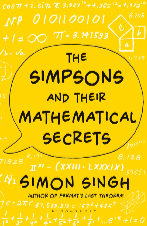 I am indebted to Simon Singh's excellent new book The Simpsons and their Mathematical Secrets, which I recently reviewed, for providing me with what must be the longest trivially memorable prime number at a whopping 31 digits.
I am indebted to Simon Singh's excellent new book The Simpsons and their Mathematical Secrets, which I recently reviewed, for providing me with what must be the longest trivially memorable prime number at a whopping 31 digits.Prime numbers are much loved by mathematicians. Of itself this is no great achievement - mathematicians are routinely besotted with numbers that only their parents could love - but primes are genuinely interesting. (For a start, the RSA mechanism that keeps your banking details safe when you buy online depends on them.) You will probably remember from school that primes are the whole positive numbers that are only divisible by themselves and 1 - so they begin 2, 3, 5, 7, 11, 13, 17...
You may wonder why 1 is not a prime and you would not be alone. In fact it was until a couple of hundred years ago, when mathematicians decided it was too unique (they probably missed the pun) and excluded it. Mathematicians can do this (unlike physicists), as they make up their own rules.
The number revealed in the book is Belphegor's prime, named after one of the princes of Hell, though I think it would be much better called the devilish prime. One thing that helps make it memorable is that it is a palindrome - it reads the same forwards as backwards - but the main (dare I say, the prime) reason it springs to mind so easily is its devilish construction.
Start with the number of the beast, 666 and stick a horribly unlucky 13 zeroes either side. Finally cap it off with bookends of 1 and you get
1000000000000066600000000000001
... a 31 digit prime number that is entrancingly memorable. Thanks, Simon!
Published on January 02, 2014 02:31
December 31, 2013
Educational good news
 Approaching the town hallThis is a time of year that is associated with good news, so it is great to be able to bring some good educational news when we are always hearing bad things about schools, universities and Michael Gove. Just over a week ago, though it seems a lot longer thanks to Christmas, I was at Rochdale Sixth Form College's awards ceremony.
Approaching the town hallThis is a time of year that is associated with good news, so it is great to be able to bring some good educational news when we are always hearing bad things about schools, universities and Michael Gove. Just over a week ago, though it seems a lot longer thanks to Christmas, I was at Rochdale Sixth Form College's awards ceremony.Located in the imposing Victorian gothic grand hall of the Town Hall, the event was a celebration of the year's leavers' achievements, the majority now at university, and it turned out to be one of my favourite events of the year. My role was to give a motivational speech and to hand out around 200 certificates, accompanied with the obligatory smile and photo - which sounds like a very repetitious task, but saying hello to all the different students made it surprisingly enjoyable.
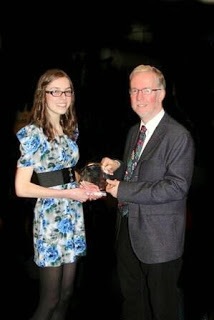 With RSFC student of the year
With RSFC student of the yearRhiann CanavanThe reason I say it was good educational news was down to the remarkable achievements that the staff and students have made. Four years ago, RSFC was just a construction site, located in a borough that was one of the worst in the country for sixth form achievement. But in its short life, RSFC has become one of the few sixth form colleges to get an outstanding Ofsted and is rated one of the top colleges in the country.
There are times when it is difficult to be proud to come from Rochdale - but this was definitely one where my home town deserves a few accolades.
Here's to a great 2014 for all of us, but especially for Rochdale Sixth Form College and its leavers, who I had the pleasure to meet a few days ago.
Read more about the college in this article from the Independent.
Published on December 31, 2013 01:45
December 30, 2013
It doesn't need saving
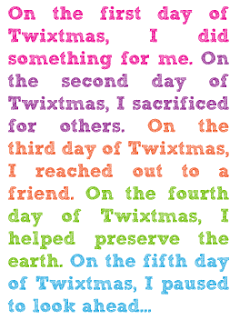 The graphic that made me grumpyWhen I made the remark online 'I sometimes feel that the period between Christmas and New Year is what being retired would be like, but with more tinsel', someone kindly pointed me to the Twixtmas website. The website itself is excellent, promoting the idea of doing something worthwhile with those days - but there was graphic on it that made me slightly grumpy (rare though I know this is).
The graphic that made me grumpyWhen I made the remark online 'I sometimes feel that the period between Christmas and New Year is what being retired would be like, but with more tinsel', someone kindly pointed me to the Twixtmas website. The website itself is excellent, promoting the idea of doing something worthwhile with those days - but there was graphic on it that made me slightly grumpy (rare though I know this is).I've said it before and I will say it again, because it needs repeating. We do not need to do anything to preserve the earth. It is utterly pointless trying to 'save the earth.' I don't say this because I am full of doom and gloom, but because given a few million years (a teeny snippet of time in the Earth's lifetime) our planet can shrug off any environmental messing up we can manage. The earth does not need saving, we do.
Unlike the earth, we need very narrowly fixed environmental conditions to survive comfortably - conditions, incidentally that have been decidedly uncommon in the earth's history and probably will be in the future unless we intervene appropriately. All the 'saving the planet' guff, should really be about saving humanity. And because it is the earth's nature not to spend a huge amount of time in the goldilocks zone where we are comfortable, the chances are that saving humanity is going to involve interfering with nature on a large scale, which is decidedly scary.
I am not saying we shouldn't try to minimise future climate change, because we should. We probably did need some global warming to avoid going back into an ice age (we are currently in an interglacial), but we've had more than enough to do that, and now we need to stop quickly to avoid going too far the other way. But it's certainly not as simple as being green and returning to nature.
So there we have it. Do something great with the period between Christmas and the New Year (I can't bring myself to call it Twixtmas), but don't attempt to preserve the earth. It will just end in tears.
This has been a Green Heretic production
Published on December 30, 2013 01:41
December 25, 2013
Simply
Published on December 25, 2013 01:09
December 19, 2013
Diamonds are so last century
 Most simple inorganic compounds - think sodium chloride, for instance - are amongst the more familiar substances. But boron nitride, just boron and nitrogen is something most of us have never heard of. Which is amazing when you consider how remarkable it is. Because its electronic structure is similar to carbon it can take all the forms that carbon does, from an equivalent of the wonder material graphene to a diamond substitute - and often it does the job better than the original.
Most simple inorganic compounds - think sodium chloride, for instance - are amongst the more familiar substances. But boron nitride, just boron and nitrogen is something most of us have never heard of. Which is amazing when you consider how remarkable it is. Because its electronic structure is similar to carbon it can take all the forms that carbon does, from an equivalent of the wonder material graphene to a diamond substitute - and often it does the job better than the original.So prepare to get all abrasive as you hurry over to the RSC compounds site to see more on this useful inorganic compound. If you'd like to listen straight away, just click here.
Published on December 19, 2013 01:04
December 18, 2013
Universally Challenged
 Earlier this year I was surprised and delighted to be the answer to a question on University Challenge, the venerable and much-loved quiz show, so I was even more filled with jollity to be asked to appear on the Lancaster team for the Christmas edition of the show, which features graduates with a little more experience of life, the universe and everything, rather than the usual youths. The format otherwise, though, is the same, down to the sizzling quizmastership of Jeremy 'Take No Prisoners' Paxman.
Earlier this year I was surprised and delighted to be the answer to a question on University Challenge, the venerable and much-loved quiz show, so I was even more filled with jollity to be asked to appear on the Lancaster team for the Christmas edition of the show, which features graduates with a little more experience of life, the universe and everything, rather than the usual youths. The format otherwise, though, is the same, down to the sizzling quizmastership of Jeremy 'Take No Prisoners' Paxman.The result of the invitation was a trip to the ITV studios in the glossy new MediaCity development that has transformed the old Salford Docks into something rather glamorous. Across the water, Coronation Street actors smoulder on their new set, while in the main development BBC and ITV come together in a friendly merge that is somehow well reflected in the way ITV makes University Challenge for its old rivals.
MediaCity is worth an exploration in its own right - and we were staying in the Holiday Inn that is right in the middle of the complex - but inevitably the highlight was the filming of the show itself. I was one of the less experienced of the contestants when it came to TV, but even old hands were a little nervous at taking part in such an institution. In total there were 14 teams taking part, of which 4 would go through to the semi-finals, representing a handful of Oxbridge colleges and some of the more modern institutions.
I can't deny I was nervous, but when it came down to it, it was great fun. Our team genuinely enjoyed it in the good old British sense of 'it's the taking part that counts', so win our lose, we were in it for the enjoyment. This helped hugely by the make up of the team - brilliant people one and all. Apart from me, Lancaster was represented by the Daybreak news presenter Ranvir Singh, the film actor (also about to be in Games of Thrones) Roger Ashton-Griffiths and the food critic and TV food judge Matthew Fort. I can say nothing about the result - but we had a truly brilliant experience (probably best of all socialising over a meal afterwards).
If you want to see Christmas University Challenge in action it starts tonight, Friday 20 December, on BBC2 at 7.30pm. Our match against the University of Kent is on tomorrow night, 7.05pm, again on BBC2.
 Photo (c) ITV Studios, reproduced with permission
Photo (c) ITV Studios, reproduced with permission
Published on December 18, 2013 06:34
Don't panic
Published on December 18, 2013 00:38
December 17, 2013
Christmas challenge
 Ho, ho, ho!It's that time of year when we're dashing around madly, but at the same time work sometimes slows down a bit. When better moment to take a break from thrashing around for a little light entertainment.
Ho, ho, ho!It's that time of year when we're dashing around madly, but at the same time work sometimes slows down a bit. When better moment to take a break from thrashing around for a little light entertainment.And so we proudly present the Now Appearing Christmas Mostly Musical Quiz . There is no prize (though do feel free to add a comment saying how you did) - just the satisfaction of knowing stuff. Or not.
No Wikipedia or Google cheating please - just try from the top of your head.
The answers are down below.
1. Why do Rangifer tarandus abound this time of year?
2. How would you distinguish Father Christmas from Santa Claus in an identity parade?
3. A certain rhyme in depth:
a) Which poem introduced Santa's reindeer (a bonus if you can give both titles)?
b) Who wrote it?
c) Five years either way, when was it written?
d) Which two reindeer have variant spellings of their name (a bonus for the variants and why)?
e) Who wrote the poem that introduced a ninth reindeer?
f) Three years either way, when was it written?
g) Who set the poem to music?
h) Three years either way, when was it written?
4. What is a macaronic carol?
5. What date is Holy Innocents Day?
6. A funky music collection of 1582 introduced Christmas hits like In Dulce Jubilo (it dates back to the 13th century, but this made it), Gaudete!, Unto us in Born a Son and the tune of Good King Wenceslas. What was it called? (Bonus for the country it originated)
7. Where was Wenceslas a king, what was his actual name and when did he reign (10 years either way)? - three marks up for grabs!
8. Who wrote Silent Night - a mark each for the two (surnames will do)?
9. Multiply drummers drumming by swans a swimming and take away ladies dancing. What do you get?
10. Time for a Christmas drink...
ANSWERS
COMING
UP
±
±
±
±
DON'T
PEEK
±
±
±
±
ANSWERS
1. Rangifer tarandus are reindeer (or caribou).
2. Father Christmas wears a full length hooded cloak in either red or green. Santa Claus wears separate hat, jacket and trousers in red with white trim, and a broad black belt.
3. A certain rhyme in depth:
a) Twas The Night Before Christmas - A Visit from St Nicholas
b) Clement Clark Moore
c) 1823
d) Donner & Blitzen / Dunder or Donder & Blixem - the second set (used in the original) are the Dutch words for thunder and lightning
e) Robert L. May
f) 1939
g) Johnny Marks
h) 1949
4. A carol in more than one language, typically Latin and English/ language of your choice
5. 28 December
6. Piae Cantiones - Finland
7. Bohemia, Vaclav, 922-929
8. Mohr and Gruber
9. 75
10. Mine's a pint
Image from Wikipedia, by Douglas Rahden
Published on December 17, 2013 00:19
December 16, 2013
Science needs hands on
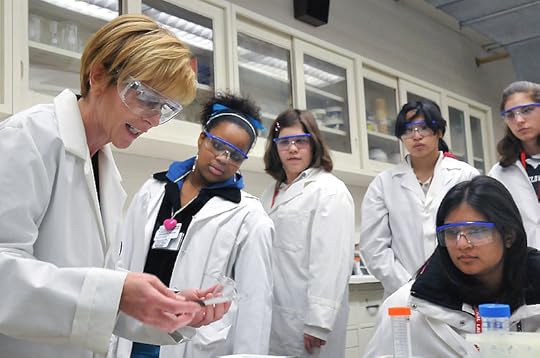 What's happening here? Whatever it is, it's not worth examiningI had the pleasure last week of speaking at event for heads of science from secondary schools in the East Riding of Yorkshire. Before my own session I sat in on their get-together where they were primarily discussing the many and byzantine changes to the exam system that the government and Mr Gove's latest whims have brought about.
What's happening here? Whatever it is, it's not worth examiningI had the pleasure last week of speaking at event for heads of science from secondary schools in the East Riding of Yorkshire. Before my own session I sat in on their get-together where they were primarily discussing the many and byzantine changes to the exam system that the government and Mr Gove's latest whims have brought about.Two things struck me as an outsider. One was that, rather than simplifying the exam system, every change seemed to make it more complicated. Rather like the way the tax system has got more and more complex over the years, the exam system, particularly once you take in GCSEs, iGCSE equivalents, GCE, BTEC, requirements for the eBac, the three buckets* etc etc has become a tangled mess. Frankly both could do with a 'start again from the beginning', though I accept that the last thing teachers need is yet another upheaval.
However one specific thing stuck out like the veritable sore thumb. In describing the revised A-levels to be implemented in a couple of years' time, there was a statement that was so bizarre that it could only have come from an arts or history graduate. (What did Mr Gove study?) It seems that in the new A-levels, practicals will not contribute at all to the final grade. Apparently, the government is so obsessed with moving to 'traditional' exams and away from coursework, with that dangerous possibility of influence from the teachers creeping in, that they won't be counting any form of practical examination towards grades, as they can't be sensibly externally marked.
This is just ludicrous. Even if you are 'back to the way it was in our day' mode, practicals played an important part in A-level exams 30 or 40 years ago. Of course there are purely theoretical scientists, but to exclude the importance of experimentation for everyone at age 17 or 18 makes no sense. Practical skills in experiments should be as important in science as maths or remembering formulae - quite possibly more so. Let's face it, Michael Faraday would not have got far with an exam where the grade entirely ignored practical ability.
I am more than mind-boggled, I am fuming. Which means I probably should be in a fume cupboard. But whether or not a student could manage this we will never know, because doing experiments is apparently not significant in science any more.
* Don't ask. But it is the official term.
Image from Wikipedia
Published on December 16, 2013 00:32





